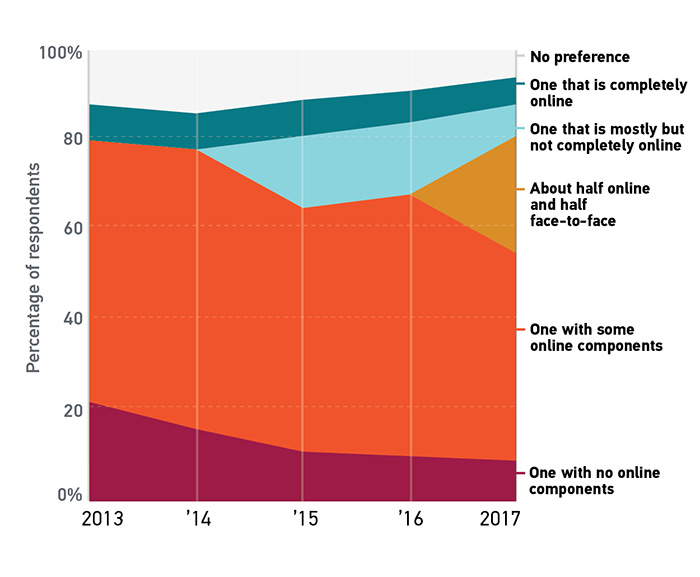Teaching and Learning in Blended Environments
The LMS often supports the integration of tools and technologies into teaching and learning. Of course, what it means to "integrate" a tool into an LMS depends on the tool. Many tools are implemented as components of the LMS, such as discussion forums and gradebooks. Other tools may be integrated into an LMS with minimal setup, such as those that make an application programming interface (API) available for Learning Tools Interoperability (LTI) integration. Still other tools may not be integrated into the LMS at all (such as polling tools or statistical analysis packages), though the instructor may use the LMS to point students to the tool.
Blended instruction has stronger learning outcomes than either face-to-face or online learning alone.1 While it seems unlikely that many undergraduate students are aware of the body of research on this topic, students are perfectly aware of their own preferences. And their preferences align neatly with this best practice: 79% of respondents to the 2017 EDUCAUSE Center for Analysis and Research (ECAR) student study said that they prefer to learn in a blended environment (see figure 1). Not only do students prefer a blended environment, but they also believe that such an environment is beneficial to their academic success: 77% of students believe that they learn best in a blended environment, a position also supported by research.2

Students were asked what type of learning environment they prefer, and faculty were asked an analogous question: In what type of learning environment do they prefer to teach? ECAR has conducted fewer studies of faculty than of students and so does not have longitudinal data available for an equivalent timespan. Nevertheless, the 2017 findings about faculty preference closely parallel those about students: Far and away the majority (71%) of faculty prefer teaching in a blended environment (see figure 2).

It is often the LMS that enables blended learning, as the LMS may be used as the platform by which other tools are made available. And the usefulness of the LMS as this central hub is reflected in student and faculty attitudes about it: Not only do students prefer to learn in a blended environment, but 87% of students also wish their instructors would use the LMS more. Likewise, faculty prefer to teach in a blended environment, and 74% of faculty agree or strongly agree that the LMS is critical to their teaching.
Notes
-
Barbara Means, Yukie Toyama, Robert Murphy, Marianne Bakia, and Karla Jones, Evaluation of Evidence-Based Practices in Online Learning: A Meta-Analysis and Review of Online-Learning Studies (Washington, DC: US Department of Education, 2009).
↩︎ -
Barbara Means, Yukie Toyama, Robert Murphy, and Marianne Bakia, “The Effectiveness of Online and Blended Learning: A Meta-Analysis of the Empirical Literature,” Teachers College Record 115 (New York: Teachers College, Columbia University, 2013).
↩︎